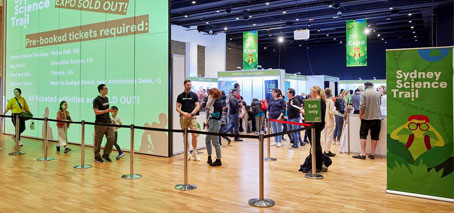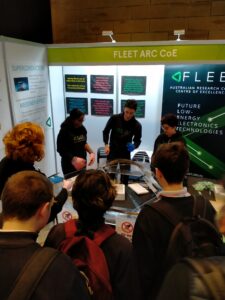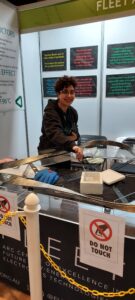More than 1000 high-school and primary students, and another 1100 members of the public were introduced to FLEET’s research and the counterintuitive world of quantum physics at Sydney Science Trail in July, in FLEET’s largest post-pandemic outreach event to date.
FLEET UNSW members were among the 20+ science orgs presenting at Sydney Science Trail, based at Australian Museum as part of National Science Week, with 15 FLEET volunteers explaining how FLEET physics fits into the bigger picture.
“It’s always fun to chat to high school students in particular and draw the link from the fun parts of science (magnets, cryogens, etc) to computers,” said UNSW’s Karina Hudson, one of the volunteers.
One tool used to captivate audiences and illustrate relevant physics is FLEET’s superconducting mobius track.
“Working on the Mobius track and seeing the excitement on people’s faces was priceless,” said FLEET volunteer PhD candidate Abhay Gupta. “It felt like a proud moment.”
“People are pretty wowed by the levitating superconductor. They are often aware that it could be used for trains but unaware that we can use it for computers,” says Karina Hudson, who is also FLEET Communications Chair.
“A lot of people are still surprised that physics and computers are linked. They were impressed that we can use the `weirder’ properties of materials to engineer better transistors,” said Karina.
FLEET volunteers used the levitating superconductor track as the main attraction to engage the public and raise awareness about the increasing energy consumption of digital technologies and the purpose and value of FLEET’s research to help develop novel solutions to help solve this problem.
Surveying of the secondary students attending suggests that this was effective, with most students having thought critically about the purpose of FLEET research, and how our society uses digital technologies. (See graph).
FLEET has another objective in running such public events: To help FLEET members improve their communication skills and gain a greater understanding of audience values and perceptions of physics/FLEET research.
FLEET volunteers confirmed that the experience had been valuable in this respect:
“Engaging the public gave me the opportunity to advocate the necessity of basic science in addressing the problems that face Australia and the global community. I believe these skills are crucial for professional scientist to successfully contribute to society.” (Aydin Keser, FLEET Research Fellow, UNSW)
“As a scientist, I believe it is crucial to be able to articulate your research clearly and convey its significance to audiences outside of your discipline. As a result, effective communication is of the highest significance. (Maedehsadat Mousavi, FLEET PhD candidate, UNSW)
FLEET/UNSW members volunteering their time at the event included: Daisy Qingwen Wang, Sue Coppersmith, Abhay Gupta, Rhianna Frahill, Maedehsadat Mousavi, Ian Thorvaldson, Vivasha Govinden, Aydin Keser, Abhikbrata Sarkar, Sina Gholizadeh, Feixiang Xiang, Karina Hudson and Jack Engdahl.

Exit survey at Sydney Science Trail tracks secondary student’s linking of the physics demonstrated with our society’s use of digital technology.
FLEET’s participation at the Sydney Science Trail was overseen by Cecilia Bloise, with assistance from FLEET’s outreach coordinator Jason Major.
Public engagement is important for FLEET to help the public think critically about the problem of our increasing reliance on and the unsustainable energy consumption of digital technologies. FLEET integrates this narrative into interactive, physics-based workshops for primary and secondary students. Please contact FLEET outreach and Education if you are interested in FLEET running workshops at your school. Email: education@fleet.org.au
More information about outreach and FLEET Schools at FLEET.org.au/education



